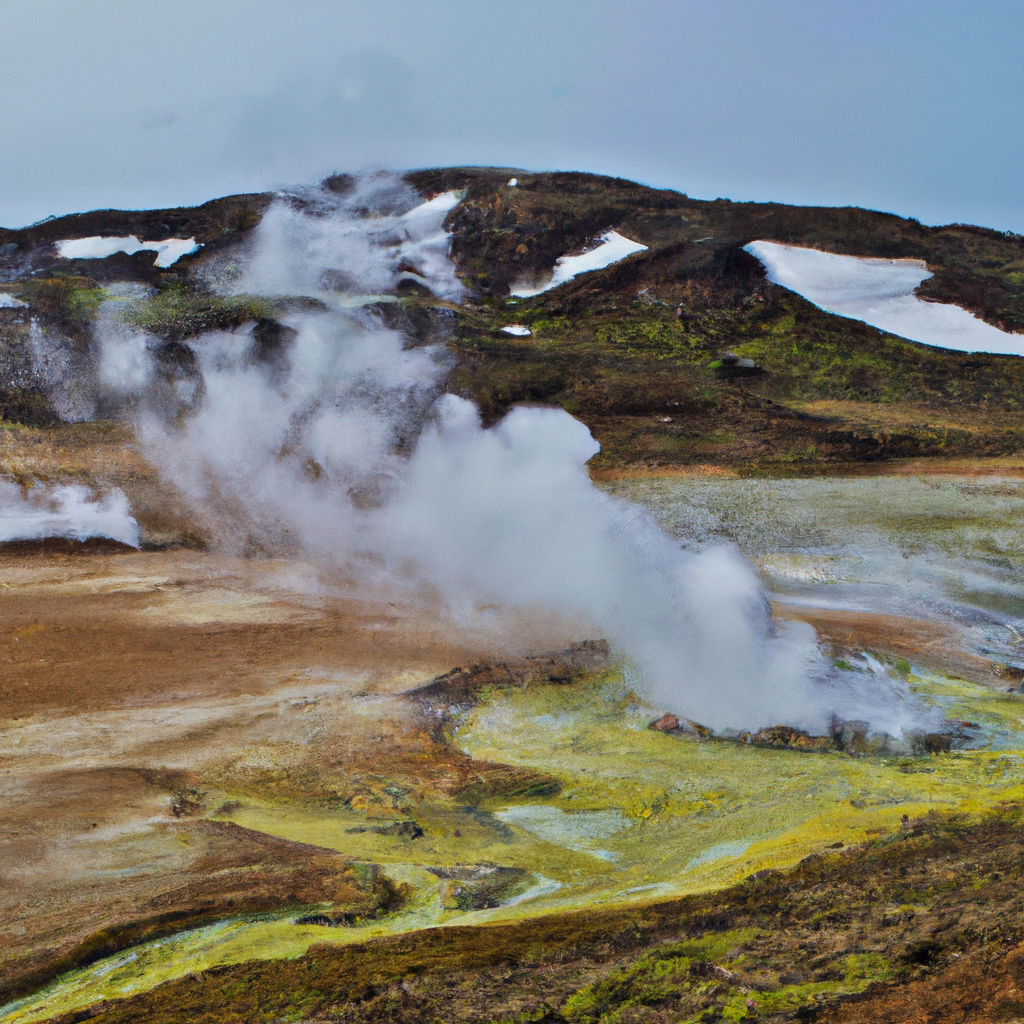Traveling around the world, the same landscapes and sights can often become mundane. But, when you explore volcanic landscapes and the geological wonders that come with them, you can experience something unique and remarkable. From bubbling mud pools to steaming geysers, there is an entire world of astonishing spectacles to ponder. Come with us and explore volcanos and their geothermal wonders.
1. A Journey Through a Volcanic Landscape
Traveling Through a Volcanic Landscape
is a truly unique experience. Breathtaking views, ash spewing volcanoes, and molten lava all set the stage for a memorable pilgrimage.
The landscapes of volcanic regions vary greatly from place to place. In Indonesia, rivers of molten lava ooze alongside majestic mountains, while Iceland has active geysers spouting smoke plumes into the air.
What unifies a volcano’s terrestrial impact, no matter where in the world, is its eco-system. Lush vegetation, including edible fruit, can be found even in the most desolate regions. The tropical forests of Hawaii are particularly striking, providing a colorful contrast against the ashy darkness.
The power of a volcanically-influenced environment should not be underestimated. The acidic soil can make a paradise into a desert in a matter of hours, and impact life forms for miles around a volcanic eruption.
In spite of the risks, should be on the bucket list of any traveler. Admiring the power of nature first-hand is incomparable, and a meaningful opportunity to connect with the planet’s strength.
- Breathtaking views
- Molten lava
- Lush vegetation
- Striking tropical forests
2. Experiencing Geothermal Wonders
If you want to get away from it all, head to some of the most spellbinding spots in the world. Traveling to experience the geothermal wonders of Mother Nature will leave you both amazed and inspired. Here are just a few wonders of geothermal energy to explore:
- Yellowstone National Park: Scenic beauty can be found everywhere in the world’s first national park. From the spectacular hot springs and bubbling mud pots to the deadly geysers, Yellowstone is a geological dream. It’s no wonder it’s the United States’ top destination for geothermal sightseeing.
- Iceland: Reykjavik, Iceland’s capital, and its surrounding area boast many geothermal wonders. Behold the power of an erupting geyser, take a dip in the Blue Lagoon, explore the lava fields, and more. Whether you’re looking for an adventure or prefer to take it all in from the comfort of a hot spring, Iceland offers inimitable geothermal experiences.
- Rotorua, New Zealand: This small-town geothermal wonder is full of steamy, sulfurous small lakes, unexpectedly colored pools, mud baths and the pervasive smell of sulfur in the air. All these might sound intimidating, but many of these spots are perfect for bathing and swimming or simply for marveling at their unique beauty.
Give all of geothermal energy’s wonders a chance to entice you. Whether you want to look down into the abyss of an erupting geyser, relax in the warmth of a hot spring or take a mud bath in a steaming lake, the geothermal marvels of world won’t disappoint.
So don’t pass up the unique opportunity to explore the incredible benevolences of geothermal energy. Take the plunge and discover all these wonders of this majestic source of energy.
3. Exploring Earth’s Fire & Fallouts
Earth is home to some of the most awe-inspiring fire and fallouts in the world. From volcanic eruptions to forest fires, each display of fire can be both beautiful and devastating in its own right. So what can we learn from these events? Let’s explore.
Volcanic Eruptions
The most iconic type of Earth’s fire, volcanoes are cones of molten rock connected to a below-the-surface chamber of magma. When that magma is forced out of the volcano through one of its vents, in the form of lava flows or ash, a volcanic eruption occurs. These eruptions can be incredibly powerful and cause destruction to the surrounding landscape. But on the other side of the coin, they also provide numerous benefits, from killing invasive species to creating new nutrients in the soil.
Forest Fires
Forest fires are a natural but devastating process. Though they can lead to a great deal of destruction, this destruction also helps promote biodiversity and the growth of new plants. For example, many seedpods require fire to activate and help spread their species even further. In addition, the nutrients found in the ash can actually help the environment more than harm it. Thus, forest fires can be a powerful tool for rejuvenating Earth’s ecosystems.
Fallouts
Fallouts are the byproducts of melting rock, vaporized metals, dust, and other debris associated with volcanic eruptions or forest fires. While typically not dangerous in nature, these fallouts can contribute to global climate change, contaminate air or water supplies, and affect Earth’s overall ecological health. As such, understanding the dynamics of fallouts can give us a better handle on how natural disasters shape our environment.
4. The Debate Around Volcanic Eruptions
When it comes to , there is plenty of passionate conversation to be had. On one hand, those in favor of eruptions argue that they serve as a natural way to replenish the landscape and bring new life to infertile areas. On the other, there are those who claim that the destruction and disruption it brings to the environment and communities that live nearby is too great a price to pay.
Some of the key arguments for eruptions point to the facts that they can:
- Bring the land back to life with vital nutrients;
- Rejuvenate soil that has been stripped of minerals;
- Increase biodiversity in areas where previously there were none.
Those in opposition to volcanic eruptions focus on the damage they can cause and the inherent risks to both those living nearby and the environment. In recent years, the effects of climate change have made the debate even more heated as scientists worry about how eruptions will affect the climate crisis. They cite issues such as:
- Air quality damage wherever the eruptions occur;
- The long-term costs to business owners, tourist destinations, and insurance companies;
- The difficulty of predicting what might happen with an active eruption.
No matter which side of the debate one falls on, it is clear that volcanic eruptions have an everlasting and powerful impact on the environment and those who call it home.
5. Capturing the Majestic Beauty of Volcanoes
Volcanoes present a breathtaking view and beautiful landscape. They are a favorite photography spot and are a captivating mystery to the human eye. From geothermal rivers to ash-covered mountain peaks – here’s how you can capture the beauty of these captivating landforms.
Use the Golden Hour
Taking photos in the “Golden Hour” is essential if you want to capture a firery-glow reflection in the clouds. This hour is usually during sunrise or sunset when the light is soft and warm. Pick a location that has a great view of the volcano and a stunning foreground. You can use the volcano as a gorgeous background in your shots.
Consider the Weather Conditions
Weather conditions will have an impact on the quality, colours, and composition of your photos. If you plan to capture volcanic eruption, make sure the sky is clear of clouds. This will help you get the best view through your lens. Be sure to check the forecast before you begin shooting, so you aren’t caught off guard by sudden changes in conditions or weather.
Choose Focal Points
- Carpeting of lava
- Smoke and vapor clouds
- Lava fountain
- Ash deposits
Having a focal point in your photograph can make a huge difference. It helps to draw your viewer’s attention to the main subject. Canopies of smoke, carpets of lava, or sprays of ash – all of these can make a remarkable focal point in your shots.
Marvel at the dynamic forces that shaped the Earth’s surface, and be thrilled by the shared human experience of exploring volcanic landscapes and geothermal wonders–it’s an unforgettable experience. Rewarding, yet humbling, it is with awe and curiosity that we can appreciate the beauty of these remarkable earthly sculptures and come to a grander understanding of our place in time and space.


